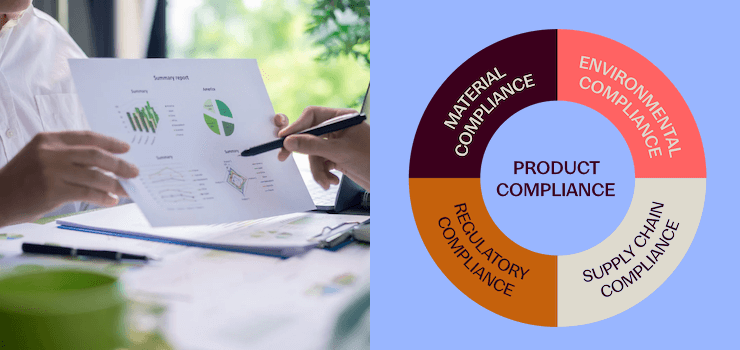The End-of-Life Vehicles Directive (ELV Directive) is a core regulation in the European Union – designed to reduce the environmental impact of end-of-life cars. It sets binding targets for reuse, recycling, and recovery and restricts the use of hazardous substances in vehicle design.
For OEMs, suppliers, and dismantlers, complying with the ELV Directive is no longer optional. Regulatory pressure is rising and sustainability expectations are reshaping the industry.
This article explains what the directive requires, how it affects your value chain and why digital compliance tools are becoming essential for future-proof operations.
Table of Contents
- ELV Directive: Key Facts at a Glance
- What Is the ELV Directive?
- Extended Producer Responsibility (EPR) & End-of-Life Vehicles
- Core Goals and Legal Requirements
- Implementing ELV Compliance: Processes and Tools
- Challenges in ELV Compliance
- ELV Compliance Is More Than a Legal Obligation
- Upcoming Changes: Review of the ELV Directive
What Is the ELV Directive?
The End-of-Life Vehicles Directive (2000/53/EC) is an EU regulation that governs the collection, treatment, and recycling of end-of-life vehicles (ELVs). It applies to all wheel motor vehicles, including passenger cars and light commercial vehicles placed on the EU market.
The directive sets out clear principles for end of life vehicle recycling, ensuring hazardous materials are safely removed and valuable resources recovered. It further defines binding standards for dismantling, depollution and material recovery.
Introduced in 2000 by the European Parliament, the directive places responsibility for vehicle lifecycles on manufacturers, from design to end-of-life treatment.
Extended Producer Responsibility (EPR) & End-of-Life Vehicles
The ELV Directive is a practical example of Extended Producer Responsibility (EPR). Under this principle, producers are accountable for the entire lifecycle of their vehicles – including the post-consumer waste phase. Manufacturers must ensure that end-of-life cars are collected, depolluted, dismantled, and recycled in compliance with EU standards. This shifts the financial and operational responsibility for proper treatment from public authorities to OEMs and suppliers, reinforcing sustainable product design and circular economy practices.
Core Goals and Legal Requirements
The EU ELV Directive provides a clear environmental framework to minimize the impact of end-of-life vehicles. Its core goals include:
- Reducing hazardous substances in vehicle design – particularly lead, mercury, cadmium, and hexavalent chromium. These are restricted, with exemptions listed in Annex II.
- Improving recyclability by encouraging the use of recycled materials and enabling safe dismantling of parts and components.
- Promoting recovery and reuse throughout the vehicle’s lifecycle, from production to treatment.
End-of-Life Vehicle Recycling Targets
To ensure implementation, the directive defines mandatory recovery and recycling targets:
- 95% of a vehicle’s weight must be reused or recovered.
- 85% must specifically be recycled.
These targets have applied to all end-of-life vehicles since January 1, 2015, as stated in Article 7(2).
Implementing ELV Compliance: Processes and Tools
Complying with the ELV regulations requires coordinated action across product development, procurement, and supplier management. Both OEMs and vehicle manufacturers must ensure full material transparency and documentation across all components and materials used in end-of-life vehicles.
Key Responsibilities Along the Value Chain
OEMs must:
- Integrate recyclability and recovery targets into vehicle design to enhance environmental performance.
- Track restricted substances across all vehicle parts and materials.
- Ensure data submission and compliance reporting to national authorities in line with EU requirements.
Suppliers must:
- Declare material content using standard formats such as the International Material Data System (IMDS).
- Provide evidence of compliance with Annex II exemptions.
- Support recyclability, reuse, and recovery documentation throughout the supply chain.
Core Industry Tools for ELV Compliance
Digital platforms help streamline reporting, ensure up-to-date regulatory mapping, and reduce supplier onboarding efforts. Without them, ELV compliance becomes manual, error-prone, and difficult to audit.
For further insights, explore IPOINT’s expertise in automotive compliance.
| Tool | Purpose | Stakeholder |
| IMDS (International Material Data System) | Central platform for declaring and reviewing material data of vehicles and components | OEMs and suppliers |
| GADSL (Global Automotive Declarable Substance List) | Defines which substances must be declared or restricted in automotive products | Product designers, material engineers |
| RRR (Reusability, Recyclability, Recoverability) Calculations | Methodology to assess reuse, recycling, and recovery rates of vehicles | Compliance teams, engineering |
| SCIP Database (for information on Substances of Concern) | Reporting requirement for SVHCs (Substances of Very High Concern) under REACH, linked to end-of-life vehicle treatment | Required in some member states |
Challenges in ELV Compliance
While the end-of-life vehicle regulations provide clear goals, implementation across global automotive supply chains remains complex. Companies face several practical and systemic challenges. Common pain points include:
- Data quality and availability: Many suppliers lack detailed or up-to-date material information, especially for legacy components.
- Inconsistent interpretation: ELV requirements are enforced differently across EU member states, creating uncertainty for manufacturers and producers.
- Limited integration: Recycling targets and substance restrictions are often not fully embedded into early vehicle design, sourcing, and treatment processes.
- Supply chain visibility: Identifying restricted substances across tier-2 and tier-3 suppliers remains difficult without centralized systems for data management.
Global Outlook: ELV Regulations in China
ELV regulations in China are rapidly evolving, with new policy frameworks designed to align more closely with global standards for end-of-life vehicles and sustainable waste treatment. For international automotive manufacturers, this development introduces additional complexity. Companies must adapt compliance strategies to cover not only the EU ELV Directive but also emerging regional regulations, ensuring full traceability, reuse, and recycling across global supply chains.
These challenges impact not only compliance with the ELV Directive but also overall sustainability and circular economy performance. They significantly increase the risk of non-conformity – with legal, financial, and reputational consequences for the industry.
Take Control of ELV Compliance With IPOINT Compliance Automotive

Whether you're managing hundreds of suppliers or submitting declarations for a handful of parts – IPOINT offers the flexibility, automation, and guidance to stay compliant and competitive.
ELV Compliance Is More Than a Legal Obligation
The ELV Directive continues to shape how the automotive industry approaches materials, design, and product responsibility. For OEMs and suppliers alike, compliance is no longer just about meeting minimum legal thresholds – it’s about enabling sustainability, transparency, and operational resilience.
Digital platforms like our Regulatory Compliance Automotive software simplify the complexity behind ELV compliance and IMDS reporting, from supplier data collection to RRR tracking and reporting. Companies that act proactively today will be better equipped to meet tomorrow’s regulatory and circular economy expectations.
Upcoming Changes: Review of the ELV Directive
The ELV Directive (2000/53/EC) is currently under review by the European Commission. In July 2023, the Commission published a proposal to replace the directive with a new ELV Regulation, aligning vehicle end-of-life rules with the EU’s Circular Economy Action Plan to strengthen circular economy practices and drive sustainability in the automotive industry.
Key proposed changes include:
- Circular design requirements: Vehicles should be easier to dismantle, depollute, and recycle.
- Mandatory recycled content: New vehicles must contain a minimum share of recycled plastics, including materials recovered from end-of-life vehicles.
- Extended scope: The regulation will gradually include additional vehicle categories such as motorcycles, buses, and trucks.
- Integration with the EU Batteries Regulation: Stronger alignment ensures that vehicle batteries are designed, reused, and recycled safely throughout their lifecycle.
- Strengthened producer responsibility: Manufacturers will carry greater financial and operational responsibility for the collection, treatment, and recycling of vehicles at end-of-life.
These upcoming changes underline that ELV compliance is a moving target. Companies that integrate recycling, recovery, and circularity into product design and supply chain management today will be better positioned for tomorrow’s sustainability and regulatory landscape.
Frequently Asked Questions
What is the End-of-Life Vehicles Directive (ELV Directive) and who has to comply?
What are end-of-life vehicles (ELVs)?
End-of-life vehicles (ELVs) are cars, vans, and other motor vehicles that have reached the end of their useful life and are no longer suitable for safe or economical use. Under the EU ELV Directive (2000/53/EC), these vehicles must be collected, depolluted, dismantled, and processed to recover valuable materials, components, and parts. ELVs are a central focus of waste policy, recycling targets, and circular economy initiatives, making their proper treatment essential for both compliance and sustainability.
Which substances are restricted under the End-of-Life Vehicles Directive?
The ELV Directive restricts hazardous materials and substances such as lead, mercury, cadmium, and hexavalent chromium in vehicles. Limited exemptions are listed in Annex II and must be justified by the manufacturer.
How can automotive companies demonstrate ELV compliance effectively?
Automotive companies can demonstrate ELV compliance by declaring material content in the International Material Data System (IMDS), following GADSL guidance, and providing recyclability, reuse, and recovery data in line with RRR targets. Digital compliance tools ensure accurate data management and traceability.
What are the main challenges in implementing ELV compliance requirements?
The main challenges in implementing ELV compliance requirements include incomplete supplier data, different enforcement across EU member states, and difficulties integrating recycling and recovery targets into early vehicle design. Global supply chains also create visibility gaps across components and manufacturers.
What are the recycling and recovery targets under the ELV Directive?
Since January 1, 2015, the ELV Directive requires that 95% of a vehicle’s weight must be reused or recovered, and at least 85% must be recycled. These binding recycling and recovery targets apply to all end-of-life vehicles placed on the EU market.
How do ELV regulations in China differ from the EU ELV Directive?
ELV regulations in China are still evolving but are increasingly aligned with global end-of-life vehicle standards. Unlike the established EU ELV Directive, China’s policies are newer, creating additional compliance complexity for international manufacturers managing cross-border waste treatment and recycling.
What does Extended Producer Responsibility (EPR) mean in the context of the ELV Directive?
In the context of the ELV Directive, Extended Producer Responsibility (EPR) means that vehicle manufacturers remain responsible for their products throughout the entire lifecycle. This includes design, material selection, production, waste treatment, reuse, and recycling of end-of-life vehicles.

.png?width=740&name=elv-directive-header(1).png)




.png)
